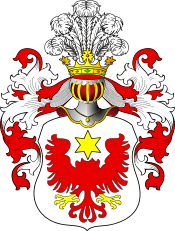Orla coat of arms
| Orla | |
|---|---|
 Battle cry: - | |
| Details | |
| Alternative names | Saszor (Szaszor) and Opola, Opala or Zapale, Mściug |
| Earliest mention | c. 14th century as Saszor subsequently Orla arms |
| Towns | various territorial manors owned by its members |
| Families | Earliest mentioned member bearers (in order of precedence):[1] * House of Saszowski (equally spelt Szaszowski) arms Saszor; and its branch scions alias Palczowski and Gierałtowski (equally spelt Geraltowski) * House of Barski (equally Bardzki) * House of Chobienicki * Jorogniewski * Kełbowski (equally Kielbowski) arms Opala * Ligocki (equally Lgocki) |
Orla (genitive form of Polish Orzeł, meaning "Eagle") - is a distinct Polish armorial estate and clan membership coat of arms adopted in Polish heraldry since the Crown of the Kingdom of Poland.[1] It was vested upon several knightly families of the Polish nobility in the historical region of Silesia and Lesser Poland, and conferred subsequently on the ennoblement of several individuals.[1]
History
Orla is one of the oldest Polish coats of arms. The coat of arms was naturalised into Polish heraldry during the Jagiellonian dynasty, it is a derivative of its Roman-German origin-precursor attributed to the personal arms borne by the House of Saszowski and its branch scions.[1]
The Polish clan coat of arms was subsequently borne as well by several unrelated Polish knightly families and individuals connected with the clan by heraldic adoption at ennoblement,[1] and as frequently found with Polish coats of arms, by some supposed members misattributed to the clan by error or usurpation.
Blazon
Silver (Argent), an eagle displayed headless red (Gules), on the neck a star of six rays red (gules); N.B. the star, as well as the eagle claws, are often found represented (rightly or wrongly) as gold (Or) tincture in Polish heraldic literature.
Notable member bearers
From the classical Polish heraldic reference Herby rycerstwa polskiego (Armorials of Polish Knights) published in 1584 by Bartosz Paprocki, bearers shown in order of precedence:[1]
- House of Saszowski, and its branch scions alias Palczowski and Gierałtowski
- Jakub Saszowski of Gierałtowic (equally known as Gierałtowski), Burgrave of Kraków and Wawel Royal Castle[2]
- Zygmunt Saszowski of Palczowic (equally known as Palczowski), (b. 1530, d. 1587), Burgrave of Kraków and Wawel Royal Castle[1]
- Jan Palczowski of Palczowic (b. about 1507, d. 1565)
- Krzysztof Palczowski of Palczowic (b. about 1568, d. 1627)
- Paweł Palczowski of Palczowic (b. about 1570, d. about 1609)
- House of Barski
- House of Chobienicki
and the individuals:
- Jorogniewski
- Kełbowski
- Ligocki
See also
References
- 1 2 3 4 5 6 7 Paprockiego, Bartosza (1584). Herby rycerstwa polskiego [Armorials of Polish Knights] (in Polish). Kraków: Wydawnictwa Biblioteki Polskiej. pp. LXXXIII & CVII, 710–711 & 891.
- ↑ Dokumenty pergaminowe Oddziału I Archiwum Państwowego w Krakowie do 1600 r. (Parchments until 1600, Department of State Archives in Krakow); Data: 1569.07.11, Miejsce: Lublin, Sygnatura: W 028.

